Corsair AX1500i Power Supply Review
by E. Fylladitakis on September 11, 2014 5:00 AM EST- Posted in
- Cases/Cooling/PSUs
- Corsair
- PSUs
- 1500W
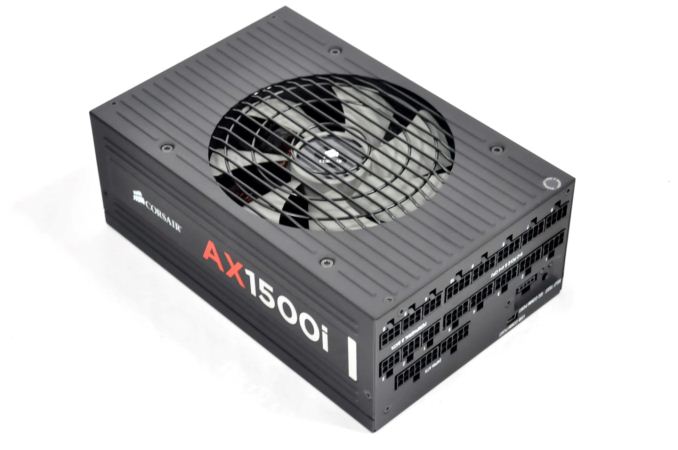
Introduction
A decade ago, the 80 Plus program was introduced with the aim of promoting the development of more efficient and environmentally friendly computer power supplies units (PSUs). When it was officially included in the Energy Star 4.0 specification requirements in 2007, the program really took off, with every manufacturer who had not already certified their units sprinting to do so.
In 2008, it was already easy and fairly cheap to produce 80 Plus certified PSUs, making the original 80 Plus program somewhat obsolete, but the original standard was revised to include differing tiers of efficiency, starting with the 80 Plus Bronze, Silver, and Gold certifications. Two more levels, Platinum and Titanium, were introduced later. These "badges of honor" drove the manufacturers to funnel money into research in order to create better and more efficient units, and they significantly helped their marketing departments as well. Today, users can easily find 80 Plus Gold certified units at very reasonable prices for their home computers, and 80 Plus Titanium certified units for servers have already been available for a couple of years.
The race for more powerful and more efficient PSUs continues to this date, as every manufacturer is trying to get ahead of the competition by either developing more efficient units, or by producing cheaper units with the same level of efficiency. Today we will look at Corsair's attempt to show us who's the true king of the hill, as we are going to review the AX1500i, a fully digital 1500 Watts PSU with an 80 Plus Titanium certification and an impressive list of features.
The AX1500i is one of the first 80 Plus Titanium certified consumer PSUs, as well as one of the most powerful units currently available. These facts do help explain the rather insane retail price of $450, perhaps, but there's no question that this is a very niche product. With such a price tag and power output, the AX1500i is intended only for very advanced users and hardcore gamers who are willing to pay as much as a small home/office PC costs just to get the best PSU possible. However, this segment of the market is very demanding as well – does the Corsair AX1500i has what it takes to please such users? We will find out in this review.
| Power specifications ( Rated @ 50 °C) | |||||
| AC INPUT | 100-240 VAC, 50-60 Hz | ||||
| RAIL | +3.3V | +5V | +12V | +5Vsb | -12V |
| MAX OUTPUT | 30A | 30A | 125A | 3.5A | 0.8A |
| 180W | 1500W | 17.5W | 9.6W | ||
| TOTAL | 1500W | ||||
Packaging and bundle
The black, serious cardboard box of the AX1500i somehow hints at the proportions of the power supply. It is not deeper or taller than typical PSU packaging, but it is much wider. Information on the most vital features and performance aspects of the AX1500i can be found on the rear of the box.
For a product of this class, the bundle can definitely be described as substandard. There is only a set of four black screws, a case badge, and a C19 power cable. Note that the vast majority of consumer-grade PSUs are making use of C13 cables; C19 cables are more commonly found on servers and larger electronic appliances. Beyond the above, there are no cable ties, no cable straps, and no other accessories whatsoever included with the AX1500i, which is very strange for a product with such a price tag.
Every single cable of the AX1500i, including the 24-pin ATX cable, is a flat, ribbon-like cable with no sleeving. All of the connectors and wires are black, making them perfect for those builders that they do not want their PSU cables to stand out visually.


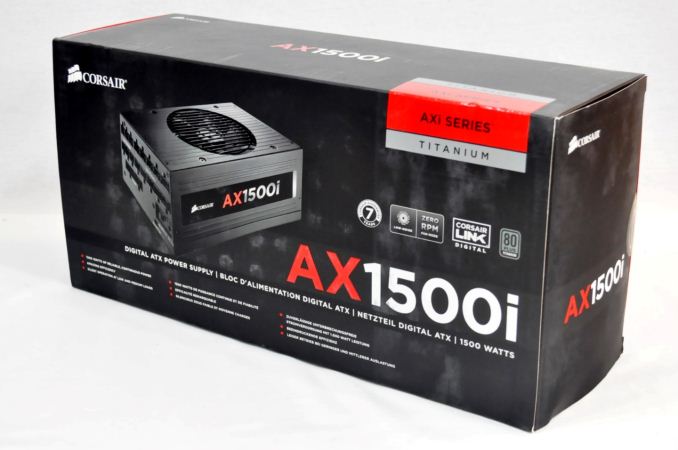
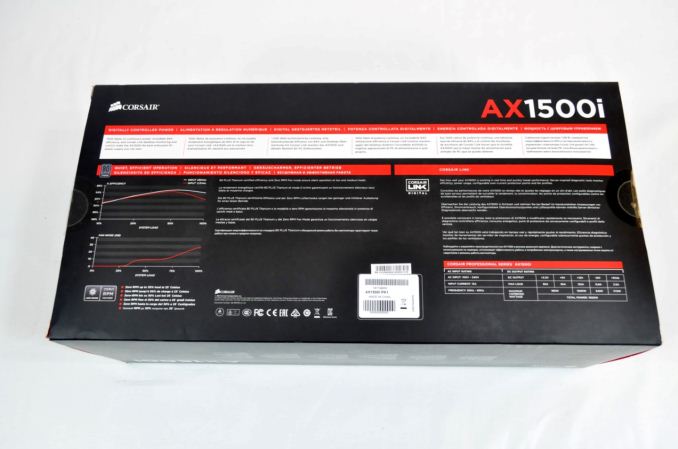
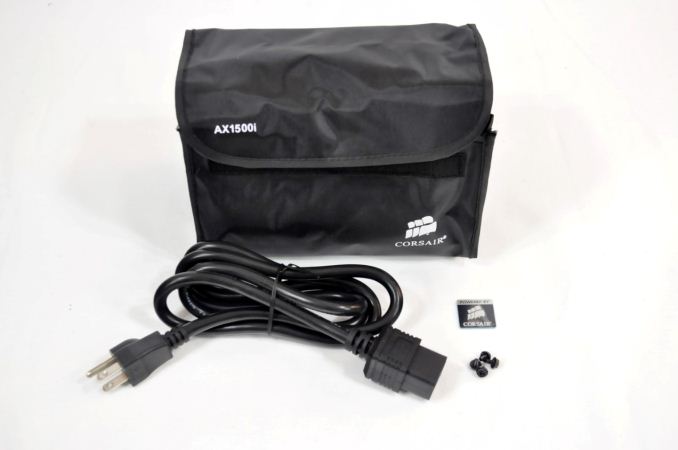
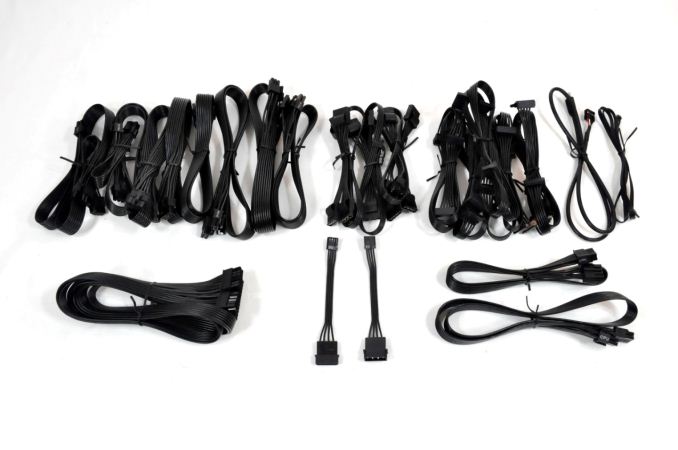








55 Comments
View All Comments
sweetca - Thursday, September 11, 2014 - link
Thank you!tim851 - Thursday, September 11, 2014 - link
>>The advantage of having more power than you need is to let the components breathe better,>>widen the pipeline so to speak.
What? This is audiophile-grade fluffy language. And a load of...
>>You may not need 1500W, but the extra headroom provides for stabilty and overclocking potential.
...bullsh!t.
You either need 1500w or you don't.
If you're overclocked setup draws 600w from the wall, having a 1500w PSU is not going to improve stability or overclocking.
quick brown fox - Thursday, September 11, 2014 - link
Maybe he worded it with some level of ambiguity, but the point he wanted to come across can be easily understood.If your overclocked setup draws 600W from the wall, theoretically you can have a 600W PSU supply all of that without the PSU going out of regulation. However, if you still have some room for additional overclocking (from better cooling), your overclocked setup might draw an additional 50-100W, and your 600W PSU (depending on its quality) won't have that headroom to sustain the additional power draw, which would lead of course to instability.
So what you're avoiding is the PSU becoming a bottleneck when you still have the capability to overclock further.
tim851 - Friday, September 12, 2014 - link
Perhaps that's what he means.But the fluffy language he uses let's me rather suspect he's one of those people who believes a higher powered PSU makes his PC faster. Because moar power!!!
Like the audiophiles who think a super-expensive HDMI cable that is thick as a child's arm is improving colors and clarity of their blu-rays.
DanNeely - Thursday, September 11, 2014 - link
Maybe. If you've got a low power system with a decent smaller PSU this would probably be worse becuase you're in the sweet spot for the smaller PSU and in the low-load suck range on this monster. if you're running a 500W box on a 550W PSU, this would probably do better at full load since the 550 would be in the nearly maxxed out suck zone; OTOH the 550 would probably still do better at idle. You normally get peak efficiency around the 50% point and good performance from 20-80% before falling off at either end (see the curves on pages 3/4).80+ Platinum is the first 80+ spec to set an efficiency requirement at 10% too; and platinum units generally do a lot better at low loads. OTOH since they're all still halo priced; unless you live somewhere with really expensive electricity they're not going to pay for themselves vs more mainstream models.
AnnihilatorX - Friday, September 12, 2014 - link
Different PSUs have different efficiency curves at different power loads, so it is hard to say. Generally they are most efficient between 20-80% load.FriendlyUser - Thursday, September 11, 2014 - link
Great product, but the price is only meant for high-end workstations and the like. I think it would be useful for such extreme products to enumerate the connectors.I am asking this because I was looking at the ASUS Z10PE workstation MB supporting dual Haswell Xeons with massive 150W TDPs. The MB in question requires 1xATX 24pin, 2x8pin EPS AND an optional but recommended 6pin EPS 12V connector for SLI/Crossfire. I haven't yet found a PSU with a 6-pin ATX 12V power connector, and I am almost certain it's not the same as PCIe.
vred - Thursday, September 11, 2014 - link
It is the same as PCIE 6-pin connector. You have not found a PSU with a 6-pin ATX 12V connector, because there is no such connector. :)
vred - Thursday, September 11, 2014 - link
Running this PSU to power my watercooled quad-Titan Black workstation running CUDA calculations. PSU remains surprisingly quiet and mildly warm to touch even under full load.philosofa - Thursday, September 11, 2014 - link
What a beautiful piece of hardware; fantastic to see something pushing so hard at the bounds that define 'well made'. Cheers for the review, was fantastic H/W pr0n to read :D